Cosmic Curiosities
“No pessimist ever discovered the secret of the stars, or sailed to an uncharted land, or opened a new doorway for the human spirit.”
~ Helen Keller
Space Junk Reality
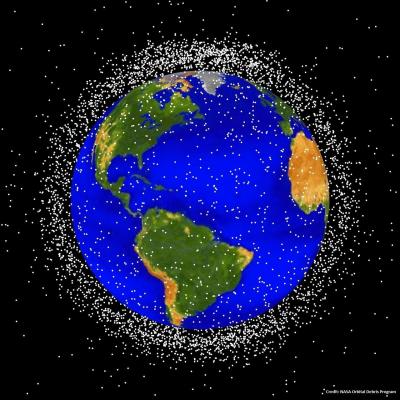 Space junk is real. Over 500,000 pieces of human construction are up there above us, orbiting the Earth only a few hundred miles away. Most of it is tiny, with only 2% larger than a softball.
Space junk is real. Over 500,000 pieces of human construction are up there above us, orbiting the Earth only a few hundred miles away. Most of it is tiny, with only 2% larger than a softball.
Though these numbers make it a serious situation that needs to be studied by every space-faring enterprise, the computer-generated maps of the debris field can make it look like a crazy-busy space highway that no one should dare enter. It seems like constant collisions are imminent, and that the astronauts aboard the International Space Station (ISS) are in big trouble. In the spring of 2016, an ISS window was hit by a small object. The crack was less than one-third of an inch, and no serious damage resulted. Astronaut Tim Peake noted the window’s thickness -- “Glad it is quadruple glazed!” See his tweet:
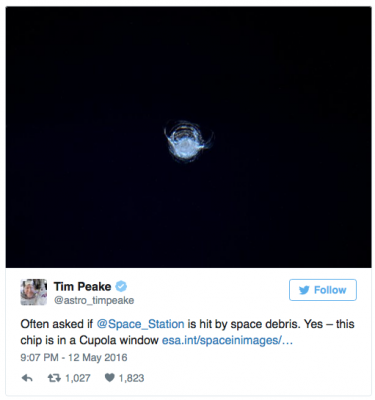
At the other end of the visual spectrum, we observe amazing pictures of Earth where it doesn’t look anything like a junkyard. The simple explanation for this emptiness is that the space objects are very small compared to our incredibly large planet. The ISS is larger than a football field at 357 feet in length; but the Earth is 7,920 miles in diameter, making the ISS invisible in full-Earth images.
The American government and private companies are tracking the debris that exists in Earth’s orbit, and more extensive efforts are planned for the future. One solution is “Space Fence,” an effort by the U.S. Air Force and Lockheed Martin. This new system is planned to be ready by 2018. Using enhanced radar technology, it will allow satellite operators more time to avoid potential threats. Currently, the ISS maneuvers itself to avoid debris heading its way.
If your computer doesn’t allow you to finish reading the end of this sentence, it might be because of a small collision with a communications…
...satellite.
Black Hole Bulletins
Death Spiral Revealed
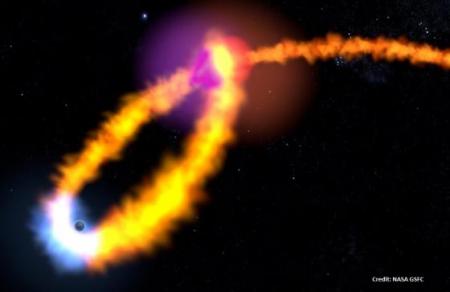
Around 290 million years ago, before dinosaurs ever walked the Earth, a Sun-like star was devoured by a black hole. Monstrous gravity produced intense tides that pulled the closer side of the star more than the farther side. This difference tore the star apart and produced a cornucopia eruption of electromagnetic energy. By analyzing optical, ultraviolet, and X-ray light, astronomers have put together an amazing video of the star’s death spiral caused by the black hole – see it here.
The mass of the black hole was equivalent to three million Suns. The results were collected by NASA’s SWIFT telescope, operated at the Goddard Space Flight Center in Maryland.
Black Hole Birthing Stars
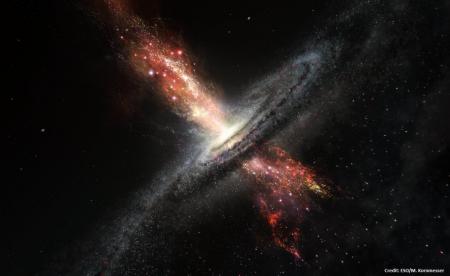
Black holes are known for their enormous gravity that can swallow stars if they get too close. The opposite is also true: black holes can give birth to stars.
Before gas and dust fall and swirl into the event horizon -- the point of no return -- the matter ricochets around with such force that it escapes along the black hole’s axis of rotation. These outpouring jets of matter can trigger star formation. Though scientists have long suspected this process, they finally have direct visible evidence from super-massive black holes at the center of two galaxies that are involved in an ongoing collision! These stunning discoveries were made by the European Southern Observatory’s Very Large Telescope in Chile.
Lunar Hurdle Headline!
This just in—the world’s newest space agency, NASO (Not Always Serious Observations), has reported an actual cow has jumped over the actual Moon.
The agency cites many eye-witness reports who were not surprised at the historic event. “She is a very intelligent animal, we always knew she would go far,” reported Dr. Ole McDonald. Another source, though unsubstantiated, claims to have helped engineer the technology that aided the epic launch beyond Earth’s gravity.
An expert in nonsensical claims, Ms. Goose, stated, “Well, the Russians sent dogs into space and America’s first astronauts were monkeys, so it is definitely possible a bovine could achieve such a feat. I suspect she had help from the local people.” Ms. Goose divulged that funding for this unprecedented lunar hurdle would likely be the CCCC (Cud-Chewing Cow Coalition).
Clara, the world’s first space cow, could not be reached for comment. She had mooved on, apparently tired from the endless jesting on the first day of April.
Sky Sights
Jupiter is up all night for most of April. The king planet is at opposition on April 7, rising as the Sun sets and setting as the Sun rises. Full Moon night is April 10-11, with Jupiter shining brightly nearby.
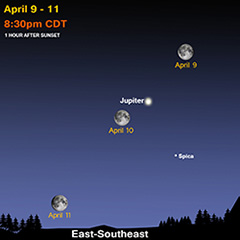
Venus is already visible in the morning sky after crossing to the other side of the Sun—as seen from Earth. Watch the hottest planet move higher each morning. By the end of the month, Venus rises almost two hours before sunrise.
Mars doesn’t have Venus to compete with in April, but the red planet rapidly is shrinking in the west. By month’s end, it’s only 10 degree high one hour after sunset. Look for a crescent Moon shining nearby on April 27-28 -- twice!
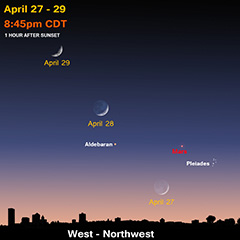
Mercury sets an hour and a half after sunset on April 1, making it fairly visible in the west-northwest sky. However, the little planet loses altitude and brilliance each succeeding night. By April 10, it will be very difficult to see unless binoculars are used.
Saturn rises 30 minutes before midnight by April 30. The ringed world is best viewed in the morning sky. Spot it near the bright red star Antares in the Scorpion. The Moon shines close by on the mornings of April 15-17.
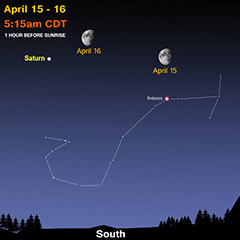
Star Map
 Download the April Star Map.
Download the April Star Map.
Sign Up
Send an e-mail to Planetarium Director Bob Bonadurer at bonadurer@mpm.edu and place 'subscribe' in the subject line to receive the Starry Messenger and monthly star map.
![]() Follow Bob on Twitter @MPMPlanetarium.
Follow Bob on Twitter @MPMPlanetarium.

